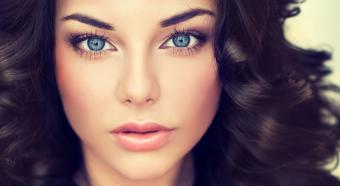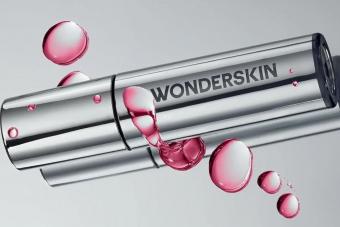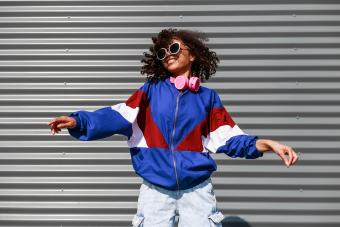
Eye shadow is a daily beauty staple for any makeup lover, but it can be challenging to know which hues will work best for your particular eye color. If done correctly, the right eye shadow will highlight your eyes and make them stand out for all the right reasons.
Choose Eye Shadow Using the Color Wheel
The best way to discern the most appropriate eye shadow color is to take a look at the color wheel. In short, colors that lie opposite each other on the color wheel tend to be more appealing and make each other "pop." These are called contrasting colors, and they are a powerful tool when it comes to choosing eyeshadow for your eye color.

Orange-Toned Shadows for Blue Eyes

For blue eyes, the color that primarily pops is orange. Consider these combinations:
- For dressy events, light blue eyes look dazzling the darker the orange eye shadow is, even as you transition into reds and pinks. Dark blue eyes are bewitching when paired with light orange, yellows, and golds. You can then use a lighter shade of the base hue as a contour in the inner and outer corners of your eye.
- If you're looking for a more understated eye shadow, opt for a color that has a slight orange undertone like pastel peach, baby pink, light coral, and cream. If you want to up the ante slightly for a smarter event, you could use a darker shade of these hues as a contour in the inner corner of your eye, on the outer corner, and in the crease.
- If your outfit is also extremely colorful or orange eye shadow wouldn't really match, then you can make your blue eyes look more intense with neutral shadows such as charcoal, gray, and chocolate brown. Then use a beige or ivory as your contour hue.
Pink-Toned Shadows for Green Eyes

Green eyes can attract a lot of attention anyway; but if you use eye shadow, this will enhance them even further. Green is opposite to red on the color wheel, and any eye shadow that has a slight pinkish or reddish undertone will really accentuate green eyes. Try some of these combinations:
- Dark green eyes are particularly stunning for a fancier occasion when teamed with deep orange eye shadow with strong pink tones.
- When it comes to light green eyes, pink shadow easily reigns supreme. Make sure you use a darker shade of the base hue to contour in the inner and outer corners to give your eyes a serious style update.
- Feminine shades like baby pink and lilac also look super cute for casual wear or to dress down a loud or complex outfit. If you want to add a gradient effect to make more of a statement, you can contour your casual eye look with a darker shade of the base hue.
Pale or Rich Shadows for Brown Eyes

Brown eyes are generally quite intense in color, but you can play them up even more by using rich tones and pale neutrals. Try some of these ideas:
- You can brighten up dark brown eyes with lighter hues like gold, ivory, beige, and light green for laid-back events. You can also contour one of these shades with any other in this family.
- Brown eyes make the maximum amount of impact for more formal occasions when paired with rich shades like violet purple, burgundy, cobalt blue, and forest green. Simply contour using a lighter tone of the base hue to highlight the inner and outer corners of your eyes, as well as the waterline.
- If you plan on matching brown eye shadow with your brown eyes, try to go much lighter than the color of your eyes. Choose a shade like warm sugar, or a brown that is more intense than your own eye color, to add more depth.
Many Options for Hazel Eyes

People with hazel eyes are lucky because they can follow the eye shadow color rules for both green and brown eyes. Try some of these options:
- From deep eggplant to soft, shell pink, you can choose from a number of hues to play up your eyes for smart casual situations. You can even use multiple shades for contouring purposes that complement each other to create unique and pretty looks. For instance, use the deep eggplant in the inner and outer corners of your eye and the lid crease. Then apply soft, shell pink shadow in the middle of the lid and use a brush to blend the two tones together for a cool gradient effect.
- If you have hazel eyes and are looking for an easy-to-wear shadow for everyday, warm neutral colors like beige, taupe, and light grey work really well. Then use a darker shade of the neutral family as your contour hue.
- Remember, you can also wear tones recommended for green or brown eyes.
Eye Shadow Styling Tips

There are a few additional things you should take into consideration when choosing an eye shadow:
- Before you decide on your eye shadow color, consider the occasion. If you're going for a casual coffee with a friend in broad daylight, you might want to avoid colors that look too heavy like charcoal or chocolate brown.
- Think about the outfit you're wearing for the occasion. Do you want your eye shadow to match your outfit colors? Do you want it to complement them? Or do you want it to contrast in a spectacular fashion? Either way, try to experiment with the above recommended shades until you find the color combination that works best.
- Metallic and shimmer eye shadows are great products to utilize when making up your eyes because they can help you wear shades that you wouldn't ordinarily go for as they're not as intense. If you're a little dubious when it comes to a bright shadow hue, try it in a metallic or shimmer first, and then build your confidence from there.
Putting It All Together
It can be difficult to know which eye shadow hues will work best with your eye color. The truth is - you'll never know until you try! Take the time to experiment and play around with different shades, and you'll soon find a winning combination you can wear time and time again.







